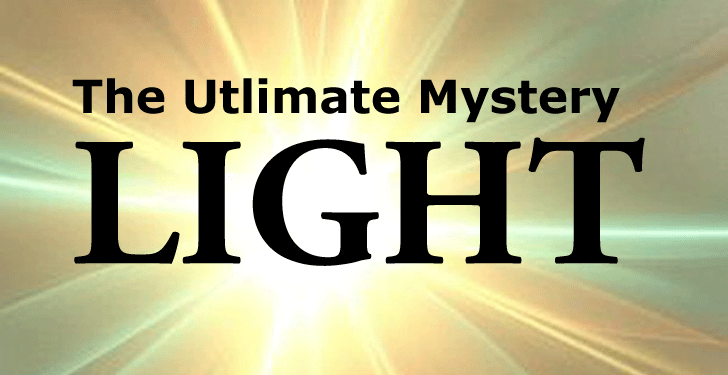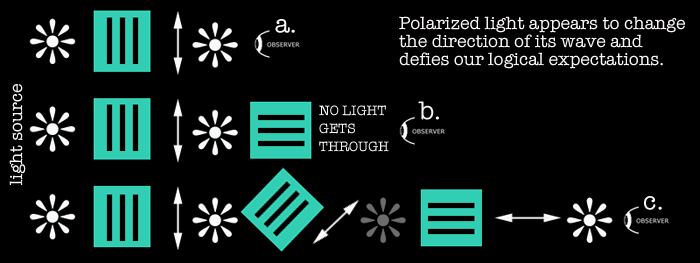

The Unexpected Happens... Again!
Get ready for another light paradox. This is an experiment you can do yourself. It involves polarizing filters of the type used in sunglasses and on camera lenses to reduce glare.
The polaroid filter is made of long molecules that are arranged in parallel in a specific direction. The filter takes advantage of the fact that a traveling light wave will have an undulating wave that extends perpendicular to the direction of travel. This wave travels at a specific angle of rotation. Actually, light travels in tiny discrete packets of energy and each packet has its own unique rotation angle. Collectively, like in a beam of light, it all seems random.
The parallel cells in the polarizing membrane allow light that is similarly aligned to pass through but blocks all the other rotation angles. So after light passes through a filter it is said to be polarized in a specific direction.
Here is a short video that will explain this better than I can:
So here is the paradox. In the illustration below you can see three different observations being made with three different arrangements of polarizing filters.

In the top row you see that a filter has been arranged to allow a vertical rotation angle. The light that passes through is visible and has a vertical orientation. [a]
The second row shows the same light passing through the first filter but being stopped by the second one because it is allowing only horizontal rotation of light to pass. There is no light visible to the observer. [b]
In the bottom row you see what happens when a filter is placed at a 45° angle between the vertical and horizontal filters. [c] Surprisingly, light now passes through all three filters.
If you can explain this, please get ready to collect your prize in Physics. Many have tried. But it remains an enigma.
But there IS a solution!
There is a modern physicist named Dr. Sylvester James Gates who is known for being the top string-theory (M-theory) theoretician. His world is usually immersed in math formulas but he enjoys relating his ideas to ordinary people in venues like the 2011 Issac Asimov discussions [below]. Dr. Gates is an speaker and used the occasion to announce a new and shocking discovery.
Gates claims that while he was solving a basic equation in the sub-quantum world of the tiniest bits that make up stuff (because they are so tiny -- smaller than quarks -- they aren't even stuff yet...) he came across a basic formula that, when solved with numbers, yielded a long stretch of 1s and 0s.
These were not random 1s and 0s. Gates immediately recognized this unique pattern as being a computer code discovered by Claude Shannon in the 1940s and used to transfer digital signals without errors.
Claude Shannon was the person who decided to send analog voice transmissions by digital means (1s and 0s) for AT&T. This successfully eliminated the noise that plagued telephones in their early days. Shannon eventually really got into digital communication and defined the limits of digital data transmission with formulas that are basic to digital communication today.
CDs, DVD, your cellphone and hard drive -- anything that sends digital information from one point to another sends it in packets. Even voice signals and skype are made up of thousands of packets a second passing through wires or space -- each has it's own "envelope" if you will -- a beginning and an end -- and something the sending device adds to it as it sends it out. This extra piece of data is something that the receiving end of the communication checks after it receives the digital package. It's a thing call an "error check code".
In its basic form, the error check code gives the count or number of bytes in the package it just sent. If the count of all the 1s and 0s is wrong, it means something got lost along the way and the receiver usually sends a message back to the sender that says "we didn't get it all, please send it again!" And a new packet is re-sent.
More advanced systems, ones that just send out the digital data and never hear back from the receiver, do something even more remarkable.
Claude Shannon devised a small addition to the packet of data that contained samples of the data in the packet. This way, if a small piece of digital information was lost, the packet from the previous successfully sent data would be used to fill in the missing data. It's all complex and you would have to be Einstein to even begin to understand it... but this whole process was reduced to a specific series of 1s and 0s that give the instruction to make the repair. This is exactly what S.J.Gates found embedded in the basic formula of string theory!
Gates stated what he found and it was confirmed. He has made no further disclosures about how it got there, if he has a clue. In one interview he apologized for being the person to suggest that the movie, The Matrix, was more true than fiction.
Is our reality a digital simulation?
Don't laugh or smirk at this idea. It has been entertained by some of the greatest minds who know the quantum world intimately. The idea that our reality is made up of discrete bits is a fact. You may be surprised to learn that there is a smallest unit of time and smallest unit of space. It's as if reality is made of pixels, which have a refresh rate (the constant velocity of light) and the ability to preserve rendering until it is observed by someone -- the avatar in the game.
Dr. Brian Whitworth has been the most outspoken theorists to "flesh out" this theory. If you have understood any of these light paradox examples in this article, you should be able to understand a little of this important paper. I've included it here so you can read it at your leisure.
Whitworth makes a compelling case for the Matrix! Things like Young's Double-Split paradox and the Delayed Choice phenomenon have a chance of making sense in a simulated world but the simulated world theories pose a threat to things like religion, "God" and free-will. It is perhaps these paradigms (including the Terror of Death that we anesthetize with religious beliefs) that keep the simulation theories at bey.
| The Similarity of Quantum and Simulated worlds
A simulated (digital computer) environment will have a maximum velocity determined by the pixel density and refresh rate of the screen. In the quantum world this frame of time is the time required for the smallest unit (Planck length) to change its position with the smallest bit of energy. Like a video game, continuous time is made up of very small moments that only appear to be continuous. In a computer game, the velocity will appear uniform in all reference frames and can be computed by dividing the pixel size by the refresh rate. In the quantum world, the same applies: Planck length / Planck time = velocity of light (1.616 X10-35)meters / (5.39 X10-44)seconds = C In video games, objects are only rendered when they are being looked at (observation). The photon exhibits this phenomenon by being a probability wave until observed by a conscious mind. In a video game, time slows when massive programming is required. Quantum time also slows in the presence of mass.
|
The Single Avatar Solution
One interesting simulation theory postulates that the "game" involves only one avatar at a time, to conserve processing. The same consciousness inhabits all of the characters in the universe, sometimes being a homeless man in New York, another time being Vladimir Putin... or YOU... and so on. You are reading this article right now because it was your turn to be who you are right now. There is only one reality for each run of the game.
This would limit the need to code everything in the universe, from every possible perspective and time. And the lifetime of an avatar could be just a small moment of time in some other reality -- where the program is running. The number of avatars is finite, so it is possible.
In the quantum world one learns that if something is possible then it is.
In this simulation example, everything that is behind you and your field of observation is not rendered -- is not "real" yet, until you turn and observe it. This explains why a photon will be a wave probability -- essentially programming variables -- until it is observed and the wave is said to "collapse" and produce a discrete particle.
If you are not familiar with computer games these days, ask your children to show you the state of the art. You will understand that this is not a fantasy.
When I described this to my good friend in Australia, John McGovern, he replied with the following youtube video which appears to say it all:
"Do unto others as you would have done to you," seems to take on new significance in this simulated world. So do things like reincarnation and karma... "We are all one!"
Maybe not so fast...
I'm very surprised that there have not been more experiments with the Double-Slit. For example, if human consciousness can collapse a wave then what about animals? How about plants? What does it mean to be conscious? When do the changes to reality occur if stored information is erased?
Also, the reaction time for consciously "knowing" something is a trifle less than a (0.8) second. This is the time required for sense organs and perception processes to take place. When does the consciousness collapse the wave? Is this delayed?
By varying the elements in the Double-Split experiment it should be possible to better understand this apparent entanglement of our minds and the natural world that we perceive as real. Yet, for 200 years, only a handful of attempts have been made to understand the process of "observation". Why?
Comments:
